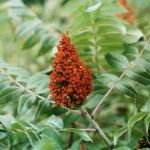| Common Name: |
Scarlet Sumac |
| Other Names: |
Smooth Sumac, Sumac |
| Botanical Name: |
Rhus glabra |
| Genus: |
Rhus |
| Family: |
Anacardiaceae |
| Native Location: |
NE USA and Canada |
| Cultivation: |
Moist, well-drained soil in sun. Cut back to ground in early spring to encourage vigorous new growth and large leaves. Plants may be damaged by die-back and various fungal diseases. Sumacs are short-lived and brittle, especially as single-stemmed specimens. Growing them as coppiced shrubs prolongs life and minimizes damage from wind and snow. |
| Propagation: |
By seed sown in autumn (species only); by semi-ripe cuttings in summer; by root cuttings in winter. Separate suckers in autumn. |
| Harvest: |
Roots are lifted as required, bark is peeled and dreid for use in decoctions and liquid extracts. Fruits are collected when ripe and dried for use in decoctions, liquid extracts and powders. |
| Height: |
3m (10ft) |
| Width: |
2.5m (8ft) |
| Hardiness: |
Z2-9 |
| Parts Used: |
Root bark, fruits, leaves. |
| Chemical Constituents: |
Albumin
Malic Acid
Resin
Tannins
Volatile Oils
|
| Properties: |
An astringent, antiseptic, mucilaginous herb with tonic effects. The bark is regarded as an alterative; the fruits are cooling and diuretic. |
| Known Effects: |
Bark:
Shrinks tissues
Prevents secretion of fluids
Inhibits growth and development of germs
Berries:
Helps body dispose of excess fluid by increasing amount of urine produced
Interferes with the absorption of iron and other minerals when taken internally
Miscellaneous Information:
Sumac is in the same plant family as poison oak and poison ivy.
|
| Possible Additional Effects: |
May treat diarrhea
May treat rectal bleeding
May treat asthma when leaves are smoked
|
| Medicinal Uses: |
Internally for diarrhea and dysentery (root bark), feverish illnesses and urinary complaints (fruits). Externally for skin irritations, sores, ulcers, vaginal discharge, and hemorrhoids (root bark). |
| Warnings and Precautions: |
Don't take if you:
Are pregnant, think you may be pregnant, or plan pregnancy in the near future.
Consult your doctor if you:
Take this herb for any medical problem that doesn't improve in 2 weeks (There may be safer, more effective treatments.)
Take any medicinal drugs or herbs including aspirin, laxatives, cold and cough remedies, antacids, vitamins, minerals, amino acids, supplements, other prescription or non-prescription drugs
Pregnancy:
Don't use unless prescribed by your doctor.
Breastfeeding:
Don't use unless prescribed by your doctor.
Infants and Children:
Treating infants and children under 2 with any herbal preparation is hazardous.
Others:
None are expected if you are beyond childhood, under 45, not pregnant, basically healthy, take it only for a short time and do not exceed manufacturer's recommended dose.
Storage:
Store in cool, dry area away from direct light, but don't freeze.
Store safely out of reach of children.
Don't store in bathroom medicine cabinet. Heat and moisture may change the action of the herb.
Safe Dosage:
Consult your doctor for the appropriate dose for your condition.
|
| Bibliography: |
Encylopedia of Herbs by Deni Brown Copyright ©: 1995, 2001 Dorling Kindersley Limited pg 344
Vitamins, Herbs, Minerals & Supplements The Complete Guide by H. Winter Griffith, MD Copyright©1998 Fisher Books pp.444-445 |

